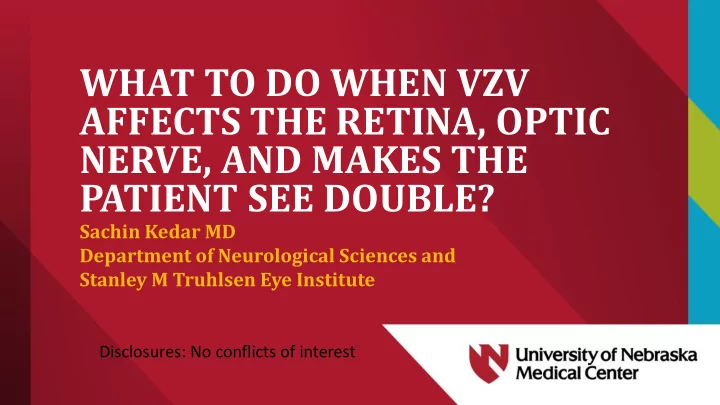

WHAT TO DO WHEN VZV AFFECTS THE RETINA, OPTIC NERVE, AND MAKES THE PATIENT SEE DOUBLE? Sachin Kedar MD Department of Neurological Sciences and Stanley M Truhlsen Eye Institute Disclosures: No conflicts of interest
Learning objectives • List neuro-ophthalmic presentations secondary to varicella zoster infection • Discuss pertinent diagnostic studies for confirming ocular zoster infections. • Describe anti-viral agents commonly used in ophthalmic varicella zoster. • Manage the neuro-ophthalmological manifestations of varicella-zoster infection
Case presentation • 76y developed a “fixed and swollen” right eye 1 week after discharge from IM. • 3wk previously- he had V1- HZ and AMS- secondary to hypoNa (116). No ocular involvement • HypoNa corrected per protocol; IV ACV for 3 days followed by 14 days oral ACV
Case presentation Anterior uveitis; fixed • pupil 3 rd nerve palsy; mild 6 th ; V1 anesthesia MRI brain: • • Orbital apex/CS enhancement • AIS- right centrum semiovale
What do we do next? • Diagnostic considerations • Therapeutic options • Long term treatment • Prophylaxis
Neuro-ophthalmic spectrum of HZ 1. Dermatologic involvement- ptosis from rash and edema 2. Ocular inflammation of all layers- conjunctiva, cornea, sclera, uvea, retina 3. Orbital inflammation- soft tissue, muscles 4. Neurological- optic nerve, cranial nerves, meningo-encephalitis, CNS vasculitis
Epidemiology of HZO • VZV reactivation in V1; 10-20% of all HZ • ~200,000 new cases annually • Frontal branch (supratrochlear/supraorbital) commonly involved • Nasociliary branch involvement (Hutchinson sign) increases risk of inflammatory disease by 3.35 times (Zaal 2003) • 5 year recurrence rate ~25% (Tran 2016)
Retinal disease • Retinal vasculitis and necrosis • Occlusive vasculopathy- arteritis and phlebitis of retinal and choroidal vasculature • Patchy or confluent areas of white or cream- Courtesy: Amol Kulkarni MD, University of Wisconsin- Madison colored retinal necrosis
Retinal disease • Common clinical forms: • ARN: immuno-competent • PORN: immuno-deficient • ARN is a CLINICAL diagnosis and medical emergency
Diagnosis American Uveitis Society criteria ≥ 1 foci of retinal necrosis with discrete borders in the peripheral retina rapid circumferential progression of necrosis in the absence of antiviral therapy Occlusive vasculitis with arteriolar involvement Prominent AC and vitreous inflammation Microbial confirmation not needed prior to treatment
Microbial confirmation • PCR to detect DNA has >95% sensitivity and specificity • May be combined with serology on paired serum/intra-ocular fluid to increase sensitivity and specificity. • No difference between aqueous or vitreous samples
Treatment • Standard treatment • Induction: IV ACV 10 mg/kg every 8 h x 7-10d • Maintenance: oral ACV 800 mg 5/d x 6w • Alternate: ARN w/o neurological involvement • Induction: PO Valacyclovir 8000 mg/d x 7-10d • Maintenance: PO valacyclovir 1000 dailyX 6m • Adjunct IVT foscarnet may improve outcome
Outcomes • Complications: VA worse than 20/200 in ~50% • Rhegmatogenous RD • Chronic vitritis, • ERM and maculopathy • Neovascularization and vitreous hemorrhage • Untreated, bilateral ARN in 70% (Palay 1991)
Diplopia in VZV • Relatively uncommon or underdiagnosed • Orbital complications leading to restrictive strabismus • Cranial neuropathy leading to paralytic forms. • Neurological complications- INO, Skew deviation
Orbital complications • Acute orbital signs: proptosis, ptosis, chemosis, ophthalmoplegia and visual loss • Radiological evidence of orbital inflammation on MRI orbit • Prompt treatment with systemic antiviral medications
Cranial neuropathy Ocular motor cranial neuropathy occurs in 7- • 31% HZO Multiple mechanisms postulated- contiguous • spread from CS; occlusive vasculitis Recommend MRI brain and orbit for • evaluation Treatment with systemic antiviral ± steroids • Prognosis for recovery excellent with • complete recovery >50%
Optic neuropathy • Extremely uncommon (<0.5% of HZO) • May be seen in acute, subacute or late stages of HZO; may accompany anterior/posterior HZO including ARN • Variable presentation • Diagnosis established by close temporal association of optic neuropathy with HZO • Should be evaluated and treated as neurological HZO • Use of steroids is controversial
HZ and GCA • Several reports of HZ leading to ischemic optic neuropathy • Several reports of HZ association with GCA based on TABx • It is unclear if HZ causes GCA • Unclear if all GCA should be evaluated for VZV serology • Unclear if GCA treatment should include antiviral; perhaps case by case basis
Prevention • Role of vaccination (will fill this section depending on Dr. Berger’s slide)
Summary • 20% of HZ can present with HZO • HZO has myriad presentations of relevance to neuro-ophthalmologists • ARN and optic neuropathy is a medical emergency and should be promptly treated with systemic antivirals. • PCR ± serology on paired sera and intraocular/CSF fluid is highly sensitive and specific • VZV vaccination is recommended to reduce incidence of HZO
Recommend
More recommend